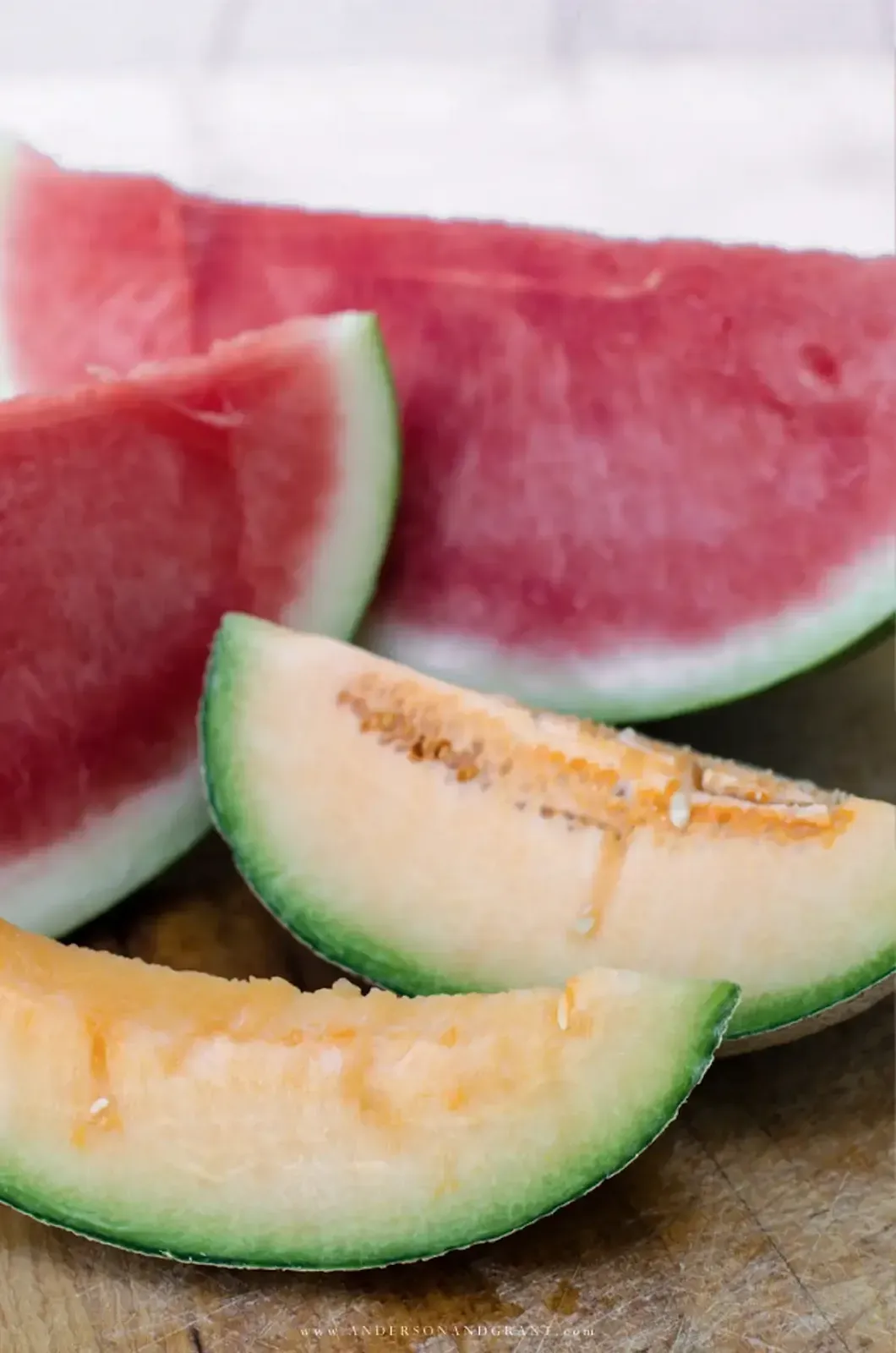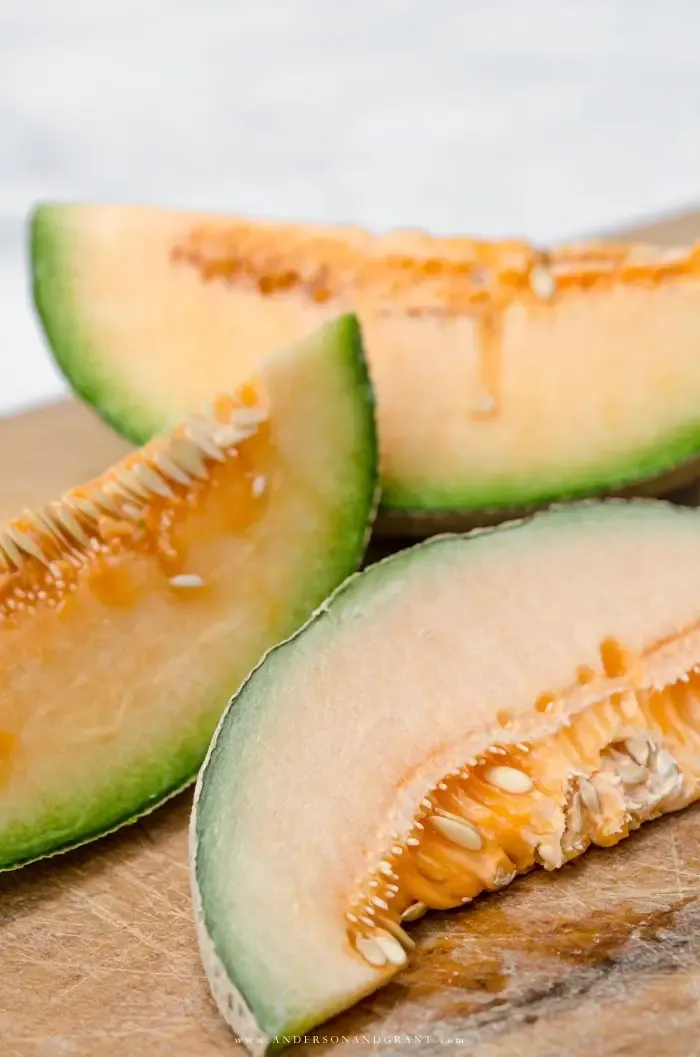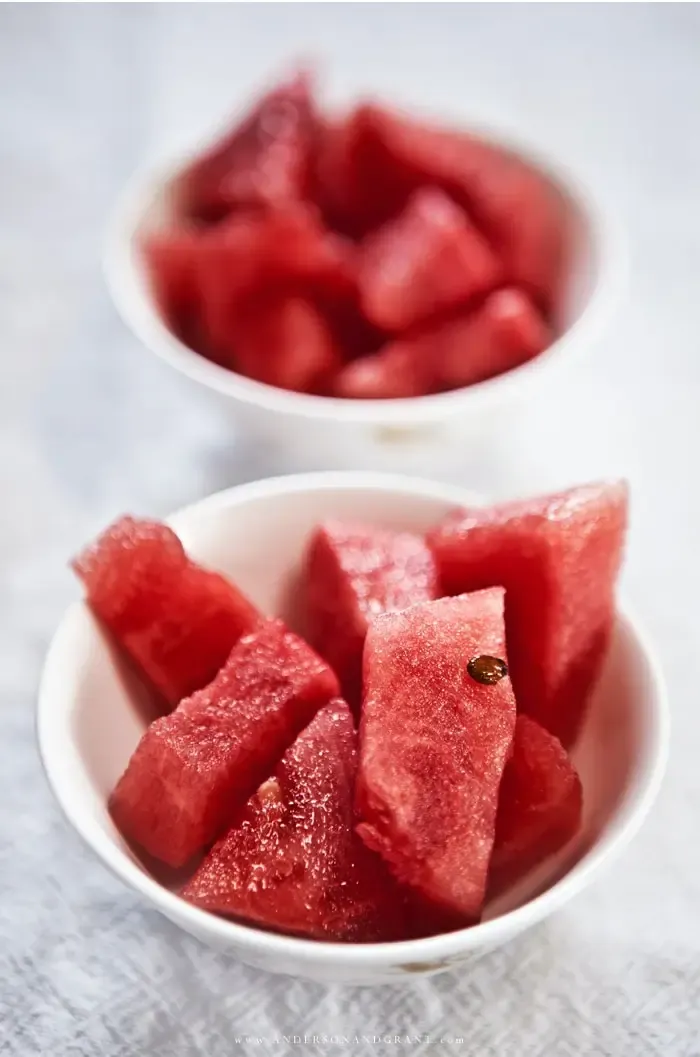Ever wish there were a way to know whether the melons you buy are sweet, ripe, and ready to eat? This post explains exactly what to look (and smell) for when shopping for watermelons, cantaloupes, and honeydew. It no longer has to be a daunting summer task!
COOK + BAKE | Updated March 20, 2023

Shopping for a perfectly ripe and juicy melon is a challenge.
It seems impossible to know what the summer fruit will be like without being able to cut into it. Nothing is more disappointing than going home from the farmers' market or grocery store with what you think is a perfect watermelon, cantaloupe, or honeydew, only to find that it is under or overripe when you serve it.
Sometimes you may feel like you just need to cross your fingers and hope for the best as you put the fruit in your cart!
Rather than arm yourself with luck, you just need to remember a few expert tips. By using your senses of touch, smell, and sight, you can find a perfectly ripe melon with the best taste.
This post may contain affiliate links which means I receive a small commission if you choose to make a purchase using the link, but there is no additional cost to you. For more information, you can view my disclosure policy.

HOW TO CHOOSE A PERFECTLY RIPE WATERMELON, CANTALOUPE, OR HONEYDEW MELON
How Do You Pick a Good Melon?
Even though watermelons, cantaloupes, and honeydew each have specific characteristics to look for when shopping, they also share some similarities. These rules apply to whatever type of melon you are picking:
TAKE YOUR TIME WHEN SEARCHING FOR THE PERFECT MELON
Don’t just grab the one on top and assume that it is as good as the rest. And realize that while it is easier to see, buying pre-cut produce is not going to be as fresh as a whole melon.
CHOOSE ONE THAT IS HEAVY FOR ITS SIZE
The weight of a melon increases as it ripens, so one that is heavier than the rest will have more juice, sugar, and flavor. Pick up a few melons that are relatively the same size to gauge a difference.
CHECK THE RIND FOR FLAWS
Inspect for bruises, cracks, scars, or soft spots that indicate a melon is no good.
LOOK AT THE COLOR
Each melon has a specific color you should be looking for (a more detailed explaination appears below). Also, a dull rind indicates a ripe melon, so avoid those that have a shiny surface.
SMELL
Cantaloupe and honeydew give off a pleasant aroma when ripe.
NO STEMS ATTACHED
A ripe melon will pull away cleanly from the vine, so there should be no stem and what remains should be smooth and inverted.

Tips for Picking a Ripe Watermelon
- The color of a watermelon indicates the ripeness of the fruit. Look for dull skin (not shiny) that has a consistent pattern of dark green and light green stripes.
- Turn the watermelon over and look for a creamy yellow field spot. This is where the watermelon was sitting on the ground ripening in the sun. A spot that is white indicates that the watermelon wasn’t allowed to ripen long enough and a bright yellow belly means it could now be overripe. Look for something similar to the color of butter.
- Also look for the sugar spot – dark brown rough patches of webbing that almost look like dirt. This is where the sugar has been seeping out and even though it might not be pretty, the sugar spot is a good thing.
- The overall shape of a watermelon should be symmetrical and uniform. Ones that are round are thought to be sweeter than the oval shaped melons which tend to be more watery and less flavorful. A lopsided melon indicates that it was picked too early.
- Run your hands over the rind of the watermelon. It should be smooth and even, without any irregular curves, dents, or bruising. An uneven texture means that the watermelon did not receive enough sun and water.

How Can You Tell if a Cantaloupe is Sweet?
- Start by looking at the stem end which should be slightly indented. Avoid ones that have the stem still attached (meaning it was cut too soon), as well as ones that are soft or moist in this area.
- The texture that looks like netting over the cantaloupe should be thick, raised, clearly defined and cream in color. A smooth cantaloupe is not ripe.
- There may be a smooth part that is lighter in color with fewer ridges. This is where the cantaloupe sat on the ground as it grew and like the watermelon’s field spot, shows you that the melon is ripe.
- The base color of the fruit should be a beige, sandy gold, or creamy yellow color. Avoid those with a greenish tint as it normally means that it isn’t ripe yet.
- The cantaloupe should feel firm all over, but not rock hard. Soft or squishy spots are a sign that the fruit is rotting.
- Cantaloupes should be oblong or round. Avoid ones not symmetrical in shape.
- Smell the fruit on the blossom end (opposite of the stem end). It should have a sweet and musky aroma. It will smell strong like perfume or have a fermented odor if the fruit is over-ripe.
- The blossom end should be soft. If it springs back out after being gently pressed in, the fruit is ripe.

How Do You Know If a Honeydew is Ripe?
- The outer rind of a ripe honeydew will be a dull, pale-yellow color. Even though the interior is a light green shade, the exterior should have no green tint to the skin. A creamy white color indicates that it hasn’t had enough time to ripen completely.
- Some brown spots are okay. This means that there is a lot of sugar in the fruit, but only buy these if you are able to eat them the same day as the spots can make the honeydew rot quicky. Green spots indicate that the fruit is under-ripe.
- Look for round, symmetrical honeydew.
- The outside of the smooth rind could feel a little bit sticky or waxy. This indicates that there is lots of sugar inside and it is coming to the surface because it is ripe.
- Smell the fruit near the stem end when the melon is at room temperature. It should smell light, clean, and slightly sweet.
- Press on the blossom end. It should be firm, but with a little give. If it is too soft, that indicates the fruit is overripe.
- If you shake a ripe honeydew, you may be able to feel the seeds rattling around inside. If you hear something that is soupy or slushy, that means it is overripe.
Fully ripe honeydew is extra sweet and juicy but hard to cut and will not keep its shape. If you intend to use it in fruit salad or sliced on a platter, look for a rind with more of a white hue for a better presentation.

Frequently Asked Questions
DO MELONS CONTINUE TO RIPEN AFTER HARVEST?
It is debatable about whether watermelons, cantaloupes, or honeydew will continue to ripen after they have been harvested. You are best to search for the ripest options when you shop. Leaving them out on the countertop for a day or two may or may not help to further ripen your fruit.
WHAT IS THE PEAK SEASON FOR MELONS?
Most melons are in season from May through September.
ARE WATERMELONS WITH SEEDS OR SEEDLESS WATERMELONS SWEETER?
Most people believe that watermelons with seeds have a sweeter flavor than the seedless varieties.
HOW LONG DO MELONS LAST? HOW SHOULD THEY BE STORED?
Watermelon
Store an uncut melon at or just below room temperature to preserve its texture and quality and use it within a week after you buy it. You can also put the fruit into the refrigerator for up to three weeks, though this will diminish its flavor.
Once you slice into the watermelon, it needs to be refrigerated. Cubes and slices of the fruit will be good for three to five days in an airtight container. Whole chunks of watermelon still on the rind should be covered with plastic wrap (or a silicone cover works well) and refrigerated.
Cantaloupe
Store cantaloupe in the refrigerator if you aren’t using it immediately where it will last for five to seven days. Cut cubes and slices will last one to two days in an airtight container once they have been cut.
Leave the seeds on any uncut portions of cantaloupe and honeydew and wrap them tightly before refrigerating. This prevents the flesh from drying out and the fruit will last for three days.
HONEYDEW
Like a cantaloupe, honeydew can be stored in the refrigerator for up to one week, although the flavor is best if used within a few days. Cut the fruit right before serving.

You may feel a little strange standing in the produce aisle tapping, shaking, and sniffing the melons they have for sale. But with time, you'll find choosing the right one to be an easier, less conspicuous task. And silly or not, isn't the point to come home with the best tasting fruit you can?
CONTINUE READING THESE POSTS IF YOU'RE INTERESTED IN MORE HELPFUL KITCHEN TIPS
TIPS FOR CHOOSING THE BEST CUCUMBERS
12 USEFUL GADGETS FOR SUMMER FOOD PREP

